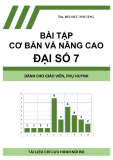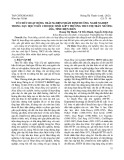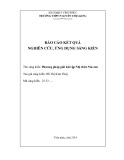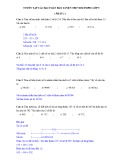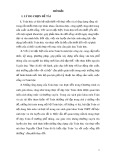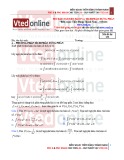The independence number of graphs with large odd girth
Tristan Denley*
Department of Pure Mathematics and Mathematical Statistics, University of Cambridge, 16 Mill Lane, Cambridge, CB2 1SB, England.
Submitted: August 6, 1994; Accepted: September 17, 1994.
Abstract. Let G be an r-regular graph of order n and independence number fi(G). We show that if G has odd girth 2k + 3 then fi(G) ‚ n1¡1=kr1=k. We also prove similar results for graphs which are not regular. Using these results we improve on the lower bound of Monien and Speckenmeyer, for the independence number of a graph of order n and odd girth 2k + 3.
AMS Subject Classiflcation. 05C15
x1. Introduction Let G be a triangle{free graph of order n with average degree d, and indepen- dence number fi(G). There has been great interest in flnding good lower bounds for fi(G) in terms of d, and producing polynomial{time algorithms which flnd large independent sets of G. In [1] and [2] Ajtai, Koml¶os and Szemer¶edi made a breakthrough in this area when they provided a polynomial algorithm to flnd an independent set of size at least
: fi(G) ‚ n log d 100d
Email to tristan@abel.math.umu.se
* Correspondence to Tristan Denley, Matematiska institutionen, Ume”a universitet, Ume”a, Sweden
1
(cid:1)(cid:2)(cid:3) (cid:3)(cid:4)(cid:3)(cid:5)(cid:1)(cid:6)(cid:7)(cid:8)(cid:9)(cid:5) (cid:10)(cid:7)(cid:11)(cid:6)(cid:8)(cid:12)(cid:4) (cid:7)(cid:13) (cid:5)(cid:7)(cid:14)(cid:15)(cid:9)(cid:8)(cid:12)(cid:1)(cid:7)(cid:6)(cid:9)(cid:5)(cid:16) (cid:17) (cid:18)(cid:17)(cid:19)(cid:19)(cid:20)(cid:21)(cid:22) (cid:23)(cid:24)(cid:19)
(cid:25)
‚ • A little later this algorithm was sharpened by Griggs in [5] , improving the constant from 100¡1 to 2:4¡1. Shearer, in [8] , improved this bound still further to give that
: fi(G) ‚ n d(log d) ¡ d + 1 (d ¡ 1)2
In [8] besides extending this result to take the degree sequence of the graph into account Shearer also considered what could be said for graphs of larger odd girth. He proved the following theorem.
nX
Theorem A. Let G be a graph of order n with degree sequence d1; d2; : : : ; dn. Suppose that G contains no 3 or 5 cycles. Let n11 be the number of pairs of adjacent vertices of degree 1 in G. Let f (0) = 1, f (1) = 4=7 and f (d) = [1 + (d2 ¡ d)f (d ¡ 1)](d2 + 1)¡1 when d ‚ 2. Then
i=1
fi(G) ‚ f(di) ¡ n11=7 :
The results of this paper are designed to deal with the case when the average degree of the graph is large. We shall prove that an r-regular graph without 3 and 5 cycles has an independence number of at least r
: fi(G) ‚ nr 6
Indeed we shall provide a polynomial{time algorithm to produce such a set of independent vertices. More generally,we shall show that an r-regular graph with odd girth 2k + 3 has an independent set of size at least
fi(G) ‚ ckn1¡1=k r1=k :
This technique can also be used to give new bounds for the independence number of general graphs of a given odd girth. We shall prove some similar bounds to those we prove for regular graphs in terms of a measure of the concentration of edges.
Monien and Speckenmeyer in [6] investigated the special Ramsey number rk(q), the largest number of vertices in a graph with odd girth at least 2k + 3, but not containing an independent set of size q + 1. They showed that
k+1 k +
q q : rk(q) • k k + 1 k k + 2
2
(cid:1)(cid:2)(cid:3) (cid:3)(cid:4)(cid:3)(cid:5)(cid:1)(cid:6)(cid:7)(cid:8)(cid:9)(cid:5) (cid:10)(cid:7)(cid:11)(cid:6)(cid:8)(cid:12)(cid:4) (cid:7)(cid:13) (cid:5)(cid:7)(cid:14)(cid:15)(cid:9)(cid:8)(cid:12)(cid:1)(cid:7)(cid:6)(cid:9)(cid:5)(cid:16) (cid:17) (cid:18)(cid:17)(cid:19)(cid:19)(cid:20)(cid:21)(cid:22) (cid:23)(cid:24)(cid:19)
(cid:26)
k
k+1 k
Combining our new bound with that of Shearer we show a new bound for the Ramsey number rk(q) (cid:181) ¶ 1
q rk(q) • k ln q
improving the previous bound provided q is large.
x2. The independence number of regular graphs In this section we shall introduce the basic algorithmic method we shall use flnd large independent sets in graphs with large odd girth at. To illustrate the ideas behind this algorithm we shall flrst prove our results for graphs of odd girth at least 7. Dealing with graphs with larger odd girth will simply require a generalisation of this argument.
Theorem 1 Let G be a graph of order n containing containing no 3 or 5 cycles with average degree „d(G) and minimal degree – ‚ 2„d(G)=3. Then
s (cid:181) ¶
n – ¡ 2„d(G) 3 fi(G) ‚ 1p 2
and there is a polynomial{time algorithm that flnds an independent set of at least this size.
s Proof. Let (cid:181) ¶¡1 1 p n m = „d(G) – ¡ 2 3 2 2
We begin by trying to greedy{colour the vertices of G with m colours. In other words we take the vertices one at a time and for each vertex use the smallest available colour. If no colour is available we ignore that vertex and proceed to the next. Firstly suppose that this greedy colouring colours at least n=4 vertices. Then, clearly, one of the colour classes will have size at least
s (cid:181) ¶
n = n 4m – ¡ 2„d(G) 3 1p 2
and we have an independent set to satisfy the theorem. Suppose then that we are not so successful and that g0 ‚ 3n=4 vertices remain un- coloured. Let A1; A2; : : : ; Am be the greedy colour classes. Consider the following algorithm SHUFFLE(c) for a real parameter c.
3
(cid:1)(cid:2)(cid:3) (cid:3)(cid:4)(cid:3)(cid:5)(cid:1)(cid:6)(cid:7)(cid:8)(cid:9)(cid:5) (cid:10)(cid:7)(cid:11)(cid:6)(cid:8)(cid:12)(cid:4) (cid:7)(cid:13) (cid:5)(cid:7)(cid:14)(cid:15)(cid:9)(cid:8)(cid:12)(cid:1)(cid:7)(cid:6)(cid:9)(cid:5)(cid:16) (cid:17) (cid:18)(cid:17)(cid:19)(cid:19)(cid:20)(cid:21)(cid:22) (cid:23)(cid:24)(cid:19)
(cid:20)
m[
Algorithm: SHUFFLE(c)
† V (G0) = V (G)n Ai;
i=1 Aij ‚ c or until every vertex of G0 has been chosen since the
i=1 † Choose v 2 V (G0); † Let I = ¡G0(v); † Let Ni(v) = ¡G(I) \ Ai for i = 1; : : : ; m; † If there is an i for which jIj > jNi(v)j then Ai = AinNi(v) [ I; m † Repeat until j last time G0 changed.
S
As usual set ¡G(I) = fv : vi 2 E(G) for some i 2 Ig. Notice that since I is the neighbourhood of a vertex and G is triangle free, I is an independent set. Thus each Ai remains an independent set throughout the algorithm. We apply SHUFFLE(n=4) to the graph.
Consider the situation when the algorithm stops. Either the greedy{colour classes A1; A2; : : : ; Am comprise at least n=4 vertices and we may argue as before, or for any uncoloured vertex v 2 V (G0)
for 1 • i • m : jNi(v)j ‚ j¡G0(v)j
m[
S
fl fl fl fl ‚ m„d(G0) : Ni(v) Suppose the latter holds. Then, given a vertex v 2 V (G0), certainly each Ni(v) is m i=1 Ni(v) an independent set, since each is a subset of a colour class, but in fact is an independent set. To prove this we need only show that there can be no edges between a vertex of Ni(v) and Nj(v) for i 6= j. Suppose that we have such an edge ab for a 2 Ni(v) and b 2 Nj(v). Let I = ¡G0(v) and consider ¡G(a) \ ¡G(b) \ I. Firstly suppose that ¡G(a) \ ¡G(b) \ I 6= ;, containing a vertex, c say. Then vertices a; b; c form a triangle in G, contradicting the odd girth of G. Otherwise, since by construction IG(a) \ I and IG(b) \ I are non{empty, there exist distinct vertices c 2 IG(a) \ I and d 2 IG(b) \ I. Then a; c; v; d; b form a 5-cycle in G, giving the required contradiction. Now, if we choose a vertex v of maximal degree in G0, we certainly have j¡G0(v)j ‚ „d(G0), and since jNi(v)j ‚ j¡G0(v)j ‚ „d(G0) we have that fl fl fl fl i=1
4
(cid:1)(cid:2)(cid:3) (cid:3)(cid:4)(cid:3)(cid:5)(cid:1)(cid:6)(cid:7)(cid:8)(cid:9)(cid:5) (cid:10)(cid:7)(cid:11)(cid:6)(cid:8)(cid:12)(cid:4) (cid:7)(cid:13) (cid:5)(cid:7)(cid:14)(cid:15)(cid:9)(cid:8)(cid:12)(cid:1)(cid:7)(cid:6)(cid:9)(cid:5)(cid:16) (cid:17) (cid:18)(cid:17)(cid:19)(cid:19)(cid:20)(cid:21)(cid:22) (cid:23)(cid:24)(cid:19)
(cid:27)
Hence the algorithm is guaranteed to flnd an independent set of size at least
r ‰ (cid:190)
: min n(– ¡ 2„d(G) ); m„d(G0) 3 1p 2
It remains only to show that „d(G0) cannot be too small. We do this with a simple counting argument. Let H0 = GnG0 and let us count the number of edges in G e(G). Then we see that
: e(G) = + g0– ¡ g0„d(G0) n„d(G) 2 2 ‚ (n ¡ g0)„d(H 0) 2 Thus, rearranging this inequality we have
„d(G) „d(G0) ‚ 2– + „d(H 0) ¡ n g0
(n ¡ g0) g0 „d(G) : ‚ 2– ¡ n g0
The right hand side of this inequality is increasing with g0. Hence, since g0 ‚ 3n=4,
3 „d(G0) ‚ 2– ¡ 4„d(G) and so using this bound we see that s ¶
n : (cid:181) – ¡ 2„d(G) 3 m„d(G) ‚ 1p 2
Thus Theorem 1 shows that provided the minimal degree is not too small, there is a large independent set in the graph. In particular, we may apply this result to the case when G is a regular graph.
Theorem 2 Let G be an r{regular graph of order n with no 3 or 5 cycles. Then
r
: fi(G) ‚ nr 6
Using a similar technique, but applying the algorithm SHUFFLE recursively we can extend Theorem 1 to deal with graphs known to have larger odd girth.
5
(cid:1)(cid:2)(cid:3) (cid:3)(cid:4)(cid:3)(cid:5)(cid:1)(cid:6)(cid:7)(cid:8)(cid:9)(cid:5) (cid:10)(cid:7)(cid:11)(cid:6)(cid:8)(cid:12)(cid:4) (cid:7)(cid:13) (cid:5)(cid:7)(cid:14)(cid:15)(cid:9)(cid:8)(cid:12)(cid:1)(cid:7)(cid:6)(cid:9)(cid:5)(cid:16) (cid:17) (cid:18)(cid:17)(cid:19)(cid:19)(cid:20)(cid:21)(cid:22) (cid:23)(cid:24)(cid:19)
(cid:28)
Theorem 3 Let G be a graph of order n with odd girth 2k + 3 (k ‚ 2) and minimal degree –(G) ‚ 2„d(G) . Then 3
k
k
(cid:181) ¶ k¡1 ¶ 1
: (cid:181) 2– ¡ 4„d(G) fi(G) ‚ n 4(k ¡ 1) 3
Proof. To construct our independent set we mimic the proof of Theorem 1 , but this time we choose
k
ˆ ! 1 ¶¡1
: m = n 8(k ¡ 1) (cid:181) – ¡ 2„d(G) 3
Firstly let us greedily colour the vertices of G just as we did in Theorem 1 but this time with (k ¡ 1)m colours. Clearly if any sm colour classes together contain at least sn=4(k ¡ 1) vertices for some 1 • s • (k ¡ 1) then immediately we have a colour class of size at least
k
(cid:181) ¶ 1 ¶ k¡1 k = (cid:181) 2– ¡ 4„d(G) n 4(k ¡ 1)m n 4(k ¡ 1) 3
as required. If not then, as before let, A1; A2; : : : ; A(k¡1)m be the greedy{colour classes. For x; y 2 V (G) let dG(x; y) be the usual graph{distance, the minimum number of edges in a path joining x to y in G. For each integer 1 • s • (k ¡ 1) and real c we deflne a new algorithm similar to SHUFFLE.
sm[
Algorithm: SHUFFLE(c; s)
s) = V (G)n
i=1
† Let V (G0 Ai
i (v) = ¡G(I(v)) \ Ai
for (s ¡ 1)m + 1 • i • sm
j (v)j then let
† Choose v 2 V (G0 s) † Let I(v) = fu; dG0 s(u; v) = k ¡ sg † Let N s † If there is some (s ¡ 1)m + 1 • j • sm for which jI(v)j > jN s
sm
s has
i=1 Aij ‚ c or until each vertex of G0
j (v) [ I(v) † Repeat from the beginning until j been chosen since the last time G0
s changed.
Ai = AinN s S
6
(cid:1)(cid:2)(cid:3) (cid:3)(cid:4)(cid:3)(cid:5)(cid:1)(cid:6)(cid:7)(cid:8)(cid:9)(cid:5) (cid:10)(cid:7)(cid:11)(cid:6)(cid:8)(cid:12)(cid:4) (cid:7)(cid:13) (cid:5)(cid:7)(cid:14)(cid:15)(cid:9)(cid:8)(cid:12)(cid:1)(cid:7)(cid:6)(cid:9)(cid:5)(cid:16) (cid:17) (cid:18)(cid:17)(cid:19)(cid:19)(cid:20)(cid:21)(cid:22) (cid:23)(cid:24)(cid:19)
(cid:29)
sm[
Now let us show that, just as our neighbourhoods in SHUFFLE form a large
i (v) is an independent set. To do this, as before
i=(s¡1)m+1
i and a vertex b of N s we show that there can be no edge between a vertex a of N s j , i 6= j. Clearly dG(v; a) = dG(v; b) = k ¡ s + 1. Thus consider paths of minimal length joining a and b to v, and let p be the vertex furthest from v at which these paths intersect (certainly since they each pass through v there is some intersection). By the minimality of the paths we must have 1 • dG(a; p) = dG(b; p) • k ¡ s + 1. Thus if ab 2 E(G) a : : : p : : : b forms a cycle of length 3 • 2dG(a; p) + 1 • 2k + 1 contradicting the odd girth of G.
N s independent set, here
jN s i Indeed similarly to the original SHUFFLE algorithm, on completion the new al- gorithm SHUFFLE(c; s) either produces a greedy{colouring of at least c vertices with sm colours, or ensures that for any vertex v 2 G0 j ‚ jI(v)j for each s (s ¡ 1)m + 1 • i • sm.
Let us now deflne the following algorithm which uses SHUFFLE(c; s):
Algorithm: SHUFFLE*(c) † do i = k ¡ 1 to 1 † do j = i to k ¡ 1 † SHUFFLE(jc; j) † continue
4 vertices remain uncoloured, thus
4(k¡1) = 3n
fl fl flV (G0
(k¡1)
smX
Let us apply SHUFFLE*(n=(4k ¡ 4)) to G. Then on completion either some collection of sm colour classes will contain at least sn=(4k ¡ 4) vertices ( for some 1 • s • (k ¡ 1)) and we immediately have a large independent set, or at least fl fl n ¡ (k¡1)n fl ‚ 3n=4, and for (k¡1)) any uncoloured vertex v 2 G0
i (v)j ‚ m(k¡s)j¡G0
k¡1
i=(s¡1)m+1
k¡1) with degree at least „d(G0
(k¡1)) then
jN s (v)j 1 • s • (k ¡ 1) :
m i=1 N 1
mX
Now if we choose v to be a vertex of V (G0 S i (v) is an independent set of size
i (v)j ‚ m(k¡1)„d(G0
(k¡1)) :
i=1
jN 1
7
(cid:1)(cid:2)(cid:3) (cid:3)(cid:4)(cid:3)(cid:5)(cid:1)(cid:6)(cid:7)(cid:8)(cid:9)(cid:5) (cid:10)(cid:7)(cid:11)(cid:6)(cid:8)(cid:12)(cid:4) (cid:7)(cid:13) (cid:5)(cid:7)(cid:14)(cid:15)(cid:9)(cid:8)(cid:12)(cid:1)(cid:7)(cid:6)(cid:9)(cid:5)(cid:16) (cid:17) (cid:18)(cid:17)(cid:19)(cid:19)(cid:20)(cid:21)(cid:22) (cid:23)(cid:24)(cid:19)
(cid:30)
Thus the algorithm guarantees to flnd an independent set of size
( )
(k¡1))
: min ; mk¡1„d(G0 n 4(k ¡ 1)m
It remains only to reapply the argument used in the proof of Theorem 1 to show that
(k¡1)) ‚ 2–(G) ¡ 4„d(G)
„d(G0 3
and hence that we have an independent set of size
k
(cid:181) (cid:181) ¶ 1 ¶ k¡1 k : 2– ¡ 4„d(G) n 4(k ¡ 1) 3
Applying this bound when the graph is r-regular graph, we immediately have an analogous result to Theorem 2 .
Theorem 4 Let G be an r-regular graph of order n and odd girth 2k + 3 (k ‚ 2). Then
fi(G) ‚ ck r1=k n1¡1=k
¡(k¡1)=k :
where (cid:181) ¶1=k
(4(k ¡ 1)) ck = 2 3
x3. Further independence results The use of the method of Section 2 is not solely limited to graphs which are almost In the non{regular case we can still flnd bounds for the independence regular. number in terms of the odd girth, but instead of the average degree of the graph we have to use another measure of the concentration of edges.
8
(cid:1)(cid:2)(cid:3) (cid:3)(cid:4)(cid:3)(cid:5)(cid:1)(cid:6)(cid:7)(cid:8)(cid:9)(cid:5) (cid:10)(cid:7)(cid:11)(cid:6)(cid:8)(cid:12)(cid:4) (cid:7)(cid:13) (cid:5)(cid:7)(cid:14)(cid:15)(cid:9)(cid:8)(cid:12)(cid:1)(cid:7)(cid:6)(cid:9)(cid:5)(cid:16) (cid:17) (cid:18)(cid:17)(cid:19)(cid:19)(cid:20)(cid:21)(cid:22) (cid:23)(cid:24)(cid:19)
(cid:19)
Theorem 5 Let G be a graph of order n with odd girth at least 2k + 3 (k ‚ 2), and let
¢0 = minf¢(H) : H ‰ G; jV (H)j ‚ n=kg
and
„d0 = minf„d(H) : H ‰ G; jV (H)j ‚ n=kg :
) ( Then (cid:181) ¶1¡1=k
; : fi(G) ‚ max ¢1=k 0 n k n log „d0 2:4k „d0
Proof. Firstly as before we can produce an independent set of size at least
n log „d0 2:4k „d0 by applying the Griggs’ algorithm to a subgraph H which achieves „d0 as its average degree.
k
To produce an independent set of the other size we mimic the proof of Theorem 3 but this time we choose (cid:181) ¶ 1
: m = n k¢0
k
1 k
Let us colour the vertices of G with (k ¡ 1)m colours. Clearly if any sm colour classes together contain at least sn=k vertices (1 • s • (k ¡ 1)) then immediately we have a colour class of size at least (cid:181) ¶1¡ 1
0 :
= ¢ n km n k
If not, then as before let A1; A2; : : : ; A(k¡1)m be the greedy{colour classes. Let us now apply SHUFFLE*(n=k).
smX
When the algorithm stops, either one of the colour classes provides us with the large independent set we desire or for any uncoloured vertex v 2 G0 (k¡1) we have
i (v)j ‚ m(k¡s)j¡G0
k¡1
i=(s¡1)m+1
jN s (v)j 1 • s • (k ¡ 1) :
(k¡1))j ‚ n=k, by deflnition of ¢0 we must be able to choose a (v)j ‚ ¢0 and for this choice we have that i (v) is an
m i=1 N 1
(k¡1)
S
mX
k
1 k
Now since, jV (G0 v so that j¡G0 independent set of size (cid:181) ¶1¡ 1
i (v)j ‚ m(k¡1)¢0 =
0 :
i=1
jN 1 ¢ n k
9
(cid:1)(cid:2)(cid:3) (cid:3)(cid:4)(cid:3)(cid:5)(cid:1)(cid:6)(cid:7)(cid:8)(cid:9)(cid:5) (cid:10)(cid:7)(cid:11)(cid:6)(cid:8)(cid:12)(cid:4) (cid:7)(cid:13) (cid:5)(cid:7)(cid:14)(cid:15)(cid:9)(cid:8)(cid:12)(cid:1)(cid:7)(cid:6)(cid:9)(cid:5)(cid:16) (cid:17) (cid:18)(cid:17)(cid:19)(cid:19)(cid:20)(cid:21)(cid:22) (cid:23)(cid:24)(cid:19)
(cid:17)(cid:31)
In particular, when k = 2 and the graph has no 3 or 5 cycles we have an analogous result to Theorem 2 and an extension of Shearer’s result, Theorem A.
Theorem 6 Let G be a graph of order n having no 3 or 5 cycle, and let
(cid:190) ‰
¢(H) : H ‰ G; jV (H)j ‚ n=2 ¢0 = min
and (cid:190) ‰
: „d(H) : H ‰ G; jV (H)j ‚ n=2 „d0 = min
Then ( ) r
; : fi(G) ‚ max n¢0 2 n log „d0 4:8 „d0
These results lead directly to a general lower bound for the the independence number of a graph in terms of its order and odd girth simply by minimising the bounds in Theorem 5.
Let G be a graph of order n with odd girth at least 2k + 3 (k ‚ 2).
k+1
1 k+1 :
Corollary 7 Then (cid:181) ¶ k
fi(G) ‚ (log n) n k
Looking at the problem the other way round, Monien and Speckenmeyer in [6] proved a bound for the Ramsey number rk(q), the largest number of vertices in a graph with odd girth 2k + 3 and independence number at most q. Monien and Speckenmeyer showed that
k+1 k +
q q : rk(q) • k k + 1 k k + 2
Using Theorem 5 once again, we can improve their upper bound.
10
(cid:1)(cid:2)(cid:3) (cid:3)(cid:4)(cid:3)(cid:5)(cid:1)(cid:6)(cid:7)(cid:8)(cid:9)(cid:5) (cid:10)(cid:7)(cid:11)(cid:6)(cid:8)(cid:12)(cid:4) (cid:7)(cid:13) (cid:5)(cid:7)(cid:14)(cid:15)(cid:9)(cid:8)(cid:12)(cid:1)(cid:7)(cid:6)(cid:9)(cid:5)(cid:16) (cid:17) (cid:18)(cid:17)(cid:19)(cid:19)(cid:20)(cid:21)(cid:22) (cid:23)(cid:24)(cid:19)
(cid:17)(cid:17)
Theorem 8 Let k ‚ 2. Then
k+1 k
(cid:181) ¶1=k
q : rk(q) • kk+2 (k + 1) log q
Concluding remarks A vertex cover of a graph G is a set of vertices U so that for every edge ab 2 E(G) a or b is a member of U . We shall write ‚(G) for the minimum size of a vertex cover of G.
The vertex cover problem then is to flnd a vertex cover U of G in polynomial time, so that jUj =‚(G) is as small as possible. The main result of Monien and Spekenmeyer’s paper [6] is to produce an algorithm to flnd a vertex cover so that this ratio is always at most 2 ¡ log log n=log n. The bound on the efiectiveness of the algorithm depends entirely on the bound which they generate for rq(k). It is thus unfortunate that although our bound improves on their bound it does so only when q is too large to improve the bound on the algorithms efiectiveness.
However it should be noted that in generating the bound for Theorem 8 for one of the bounds we assumed only that the graph was triangle free. Clearly if some result similar to those contained in this chapter could give a better bound on the independence number of a graph with large odd girth and small average degree an improvement on the bound for rq(k) and perhaps the efiectiveness of Monien and Speckenmeyer’s algorithm would be immediate.
This improvement could also be passed on to various other polynomial{time algo- rithms which use the vertex cover algorithm including, for instance, the algorithm of Blum (see [3] and [4] ) to colour a 3{chromatic graph in polynomial{time in at most O(n3=8) colours. We hope in the future to extend our results to the small degree case.
Acknowledgements I should like to thank Dr. B¶ela Bollob¶as for his helpful advice in the preparation of this paper.
11
(cid:1)(cid:2)(cid:3) (cid:3)(cid:4)(cid:3)(cid:5)(cid:1)(cid:6)(cid:7)(cid:8)(cid:9)(cid:5) (cid:10)(cid:7)(cid:11)(cid:6)(cid:8)(cid:12)(cid:4) (cid:7)(cid:13) (cid:5)(cid:7)(cid:14)(cid:15)(cid:9)(cid:8)(cid:12)(cid:1)(cid:7)(cid:6)(cid:9)(cid:5)(cid:16) (cid:17) (cid:18)(cid:17)(cid:19)(cid:19)(cid:20)(cid:21)(cid:22) (cid:23)(cid:24)(cid:19)
(cid:17)(cid:25)
References
[1] Ajtai, M.,Koml¶os, J. and Szemer¶edi, E., A note on Ramsey Numbers, J.
Comb. Theory Ser. A 29 (1980), 354{360.
[2] Ajtai, M.,Koml¶os, J. and Szemer¶edi, E., A dense inflnite Sidon sequence,
Europ. J. Comb. 2 (1981), 1{11.
[3] Blum, A., An O(n:4){approximation algorithm for 3{colouring ( and improved
approximation algorithms for k{colouring, in \Proceedings of the 21st Annual ACM Symposium on the Theory of Computing", Seattle, May 1989, pp 535{542.
[4] Blum, A., Some tools for approximate 3{colouring, in \Proceedings of the 31st Annual Symposium on the Foundations of Computer Science", pp 554{562.
[5] Griggs, J.R., An upper bound on the Ramsey number R(3,k), J. Comb. Theory Ser.
B 35 (1983), 145{153.
[6] Monien, B. and Speckenmeyer, E., Ramsey numbers and an approximation algorithm for the vertex cover problem, Acta Informatica 22 (1985), 115{123.
[7] Shearer, J.B., A note on the independence number of triangle{free graphs, Discrete
Math. 46 (1983), 83{87.
[8] Shearer, J.B., A note on the independence number of triangle{free graphs, II, J.
Comb. Theory Ser. B 53 (1991), 300{307.
12

